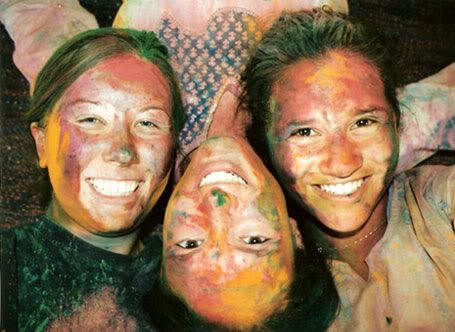One of my new favorite bloggers is Kevin Sites. In the fall of last year, he set out to cover all of the world's conflict zones, or at least some of the most active conflicts currently.
Below is his year in review article, as posted on his site today. I thought it was really interesting, and many of the places he visits are potential places where my organization could work in the future.
Our Journey So Far
A Year of the Hot Zone Completed
By Kevin Sites, Mon Sep 11, 1:36 PM ET
For nearly a year, through 22 conflict zones and 19 countries, I waited for this moment: a sense of absolution, something to wash me clean of what at times felt like an endless trail of sorrow.
The moment comes out of a murky blue, 60 feet below the ocean's surface. It comes suddenly and against the current; three shadows in the water, black and white angels, giant manta rays hovering over us in a liquid ballet.
As I watch them circle overhead, I well with emotion, sucking gulps of air from my scuba regulator. Their peaceful, silent beauty seems such a contrast to the nearly overwhelming suffering and death that I had witnessed this year.
Even underwater, I have a video camera with me. Something I routinely pointed in the direction of destruction and tragedy — the rubble of Lebanon's Bint Jbail, a funeral in northern Israel. But at this moment I cannot bring myself to point the lens in the direction of these magnificent creatures. Instead, I follow them only with my eyes, full of gratitude for this bit of serenity.
This is both a holiday and pilgrimage of sorts, a present my girlfriend Caitlin and I have given to each other after a long and difficult separation. Being here under the ocean off the Micronesian island of Yap is as seemingly far away as we can get from any war zone. And now I finally feel the journey has ended while watching what is mundane for the mantas, being cleaned of parasites by tiny fish, but magical for us.
But when an odyssey like this ends, especially one invested in the gravity of trying to report on all the world's conflict zones in one year, there is both personal and public accounting to be done.
What was accomplished? What have we learned? Did anything or anyone change because of it? There is no easy answer for any of these questions, and we will be examining them for some time to come.
Reporting from all these places felt at times both evolutionary and revolutionary.
We used some of the latest digital equipment to put a human face on global conflict and share it with the world. But technically, physically and mentally, the process was exhausting both for me, doing the physical coverage, and my Mission Control team of Senior Producer Robert Padavick, Producer Erin Green and Researcher Lisa Liu planning, prepping, packaging and posting our work.
From our first conflict zone in Somalia in September 2005 to our last in Israel this August, we had to make changes, improvise, and often work around the clock to try to make the places and the people we've met relevant to you.
People like the Afghan child bride, Gulsoma, who was given away in marriage at the age of four and tortured nearly to death by her in-law family; a Congolese woman named Serapina who was repeatedly raped by rebel soldiers and then forced to eat the flesh of her husband who was killed in front of her; a Nepalese boy named Yubaraj who at the age of 12 became head of the household when his father died and who now parks motorcycles 16 hours a day to support his family when he wishes he could be in school.
But while many of these stories are steeped in tragedy, we also hoped you could see the strength and resilience of their human spirit.
That is one of the two most important lessons that I believe were revealed to me on this journey. First, that the world is indeed filled with conflict, pain and suffering, and that amazing people overcome it everyday.
And second, that in war, it is not the combatants, but the civilian population that ultimately pays the highest price in death, injury and the legacy of destruction.
We raise statues around the world in honor of our war dead, but often forget the innocent civilian victims of conflict.
In that vein, we want to reintroduce you to the extraordinary people we met and the places we reported on during this journey, so over the course of the next four to six weeks, we are going to repost all the stories, text, video and still images, from each country in the order we covered them.
This will give you a chance to see the full scope of our year's work in a condensed time period, while also allowing us to rest and retool for the launch of the next phase of the Hot Zone, which will primarily focus on putting a face on the untold stories in America.
Thank you for sharing our journey so far.
Subscribe to:
Post Comments (Atom)

No comments:
Post a Comment